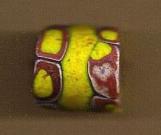1
Bead Work - OokataksinPre-Bead Period
Before the introduction of acquired beads, necklaces and decorative adornments were made from elements found in nature. The remnants of items acquired from hunting and gathering for subsistence purposes were recycled into items of adornment, utility, and spirituality. The vertebrae of fish and small animals, rosehips, dried berries, certain sweet smelling roots, and shells gathered from the rivers, could be affixed to raiment for decorative or symbolic purposes.
Bear or eagle claws, the teeth of buffalo, elk, or wolves, and the horn tips of buffalo, were strung on buckskin cords to create pendants or necklaces. The rib bones of elk or bison were the basis of long, tubular hair pipe beads, that were popular to be assembled into breastplates or neck chokers, that were both decorative and as armor for warriors.
Porcupine quills were the material of choice for First Nations women as closely woven or string decorative materials. Long thin quills from a young porcupine were preferential as being more pliable. Quillwork could be done in it's natural color, or dyed with natural ochres made from plants or minerals.
Acquired beads
Bead embroidery appeared in First Nations craft work, after contact with Europeans.
Glass beads were introduced to North American First Nations as a trade commodity, by colonial fur dealers of Dutch, Spanish, French, or English origins in the 1500s, carrying on with British, American or Canadian trading companies directly into the 1900s. Beadwork remains an integral activity within modern First Nations culture. Patterns and designs are distinctive, and display symbolisms of cultural and spiritual significance.
The tiny glass beads, also known as seed beads originated with the craftsmen of Europe, in particular in Venice, Italy. Early beads, known as "Little Glass" or "China Beads" were made of wound or drawn glass.
Working with the beads was an important part of the women's craft. To work with the acquired materials, women turned to them to their traditional crafts of quillwork for inspiration.
Pre-embroidery or Bead Necklace Period
Prior to adoption of embroidery techniques, Large beads were primarily used to make necklaces, bracelets, fringe decoration and hair ornaments
The Hudson's Bay Company, in 1748, list a trade values for beads.
One beaver pelt for a ½ lb (0.22 kg) of "Large Milk" beads
One beaver pelt for ¾ lb ( 0.34 kg) for Beads of colors
Two beaver pelts for 1 lb ( 0.45 kg) for Beads of all sorts
By the 1870s, the traders of Fort Whoop-Up were in direct contact to offer beads in trade. Large beads, or Milk Beads varied in sizes, color, shape, averaging ¼ inch (6.35 mm) in diameter; Some were larger or lacked uniformity. The colors also varied, and many had surfaces covered with varying patterns, or were monochromatic.
The Large beads were primarily used in necklaces tied with cord made from rawhide leather, bison sinew thread, or with trade, cotton string or thread. The new trade beads were alternated at intervals with claws, teeth, hair pipe bone or other native material
In 1833, explorer Prince Maximilian of Weidt said necklaces beads were purchased from the American Fur Company for the equivalent trade value of $3-$4 per pound (0.45 kg)
"Skunk beads" were a large colored bead, uniform in shape and size, often blue or red, with a raised pattern of meandering lines, with a flower bud in white or red, was considered a very old type of necklace bead. These were very rare, and considered valuable. A good horse and a buffalo robe might be traded for a necklace.
"Crow beads" were more a common type of necklace bead - irregular, monochrome, also known as "China beads" were sized from ¼ inch (6.3 mm ) diameter, and over.
The most popular color was light blue, but could also be found in medium blue, pale green, light red and black as well
Large brass beads, sometimes referred to as "iron beads," were very popular.
A small bead, 3/16 in diameter (4.76 mm) -transparent red on the outside, with a lining of opaque white-was primarily for children necklaces; also known as "Under White" beads
Embroidery beads by this time were in use, but were not intended to replace the large necklace beads
Real Bead Period
Real beads were considerably smaller than the majority of necklace beads, though larger than the seed beads used today. Real beads were irregularly shaped- 1/8 inch (3.175 mm) in diameter.
Colors ranges from monochrome, light blue, dark blue, dark red, deep yellow, white & black, blue & white were also favorable. They were sold in bunches by the "hank"-meaning 10 strings of beads, 8" long (20.32 cm). In 1870, eight hanks of beads of different colors were valued at one buffalo robe
Alexander Henry of the Hudson's Bay Company offered a detailed description of Blackfoot clothing, in the early 1800s, made no mention of the use of real beads in decorative embroidery. In 1833, Maximilian of Veidt, mentioned Blackfoot bead embroidery, noting that their preference for sky blue and white beads, in decoration of women dresses and men suits
Likely few embroidery beads were used before the American Fur Company opened trade on the Upper Missouri River in the 1830s
The acquisition of Real Beads opened the first use of embroidery. Real beads were commonly applied in narrow bands to women dresses, men's shirts, leggings, and moccasins.
Still, the technique of quillwork was never replaced by beadwork. Throughout the "Real bead" period the two crafts existed side by side, and the fastening and weaving techniques were similar with both quills and beads.
Seed Beads
The "Real Bead" period closed in the 1870s, when Blackfoot women married to White traders began to use and adopt the smaller size "Seed Bead." Though older women continued to use the older "Real Beads," younger women preferred the seed beads. The change was gradual, and women dresses were still being decorated with "Real Beads" past 1900.
"Seed Beads" are made of either wound or drawn glass, and supplied by traders in a number of sizes, all of them quite small, though usually even in size. The largest are about 1/16" in diameter (1.58 mm), about half the size of "Real Beads." Older "Seed beads" were made in Italy, and were less uniform in shape. More modern "Seed beads" have their origins in the current Czech republic, and are more uniform in shape and size.
With the advent of the "Seed Bead," the amount of beadwork on both soft skin or cloth was phenomenally increased. Traditional Blackfoot beading utilizes the "appliqué" stitch-using two threads at the same time-one string strung through the beads, and the other stitching the strung beads to the surface.
Beadwork was applied liberally to dress clothing, blanket bands, feather headdress, headbands, and containers such as awl and gun cases, arrow quivers, tobacco, paint, toilet and shot pouches. Horse and riding accoutrements such as saddles, saddle bags, martingales and riding crops were also adorned. Tipi furnishings such as cradle boards and willow back rests were decorated with symbolic designs created by multicolored beading arrangements.
The utility of the "Seed Bead," in size and color array, allowed symbolic iconography to duplicated on spiritual paraphernalia.
In 1896, the basket bead was introduced. It was transparent, 1" long, (25 mm) and 3/16" in diameter (4.76 mm). Basket beads were very popular and commonly decorated on women dresses, but the little seed bead was still favored, and remains in use by First Nations craft workers.
Much original seed beadwork is preserved in the collection of the Ksiitsikominaa-Thunder Chief Gallery at Fort Whoop-Up.
2
Awale Chevron Beads - "Ksiistsimaan"1800s
Fort Whoop-Up National Historic Site
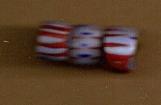 Credits:
Credits:Gord Tolton
5
Beaded Buffalo Hide Saddle Blanket - "Immoyitaan"Circa 1930s
Fort Whoop-Up National Historic Site
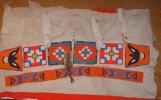 Credits:
Credits:Gord Tolton
6
Beaded Buffalo Hide Saddle Blanket - "Immoyitaan"Circa 1930
Fort Whoop-Up National Historic Site
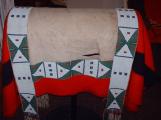 Credits:
Credits:Gord Tolton
7
Beaded Headstall - "Sotsskimma'tsis"Circa 1930s
Fort Whoop-Up National Historic Site
 Credits:
Credits:Gord Tolton
8
Multi Coloured Pipe - "Aahkoyinnimaan"Circa 2010
Fort Whoop-Up National Historic Site
 Credits:
Credits:Quinn Pereverseff
9
Blanket Strip - "Apahkiaapoko"Circa 1900
Fort Whoop-Up National Historic Site
 Credits:
Credits:Quinn Pereverseff
10
Double Blanket Strips - "Apahkiaapoko"Circa 1900
Fort Whoop-Up National Historic Site
 Credits:
Credits:Quinn Pereverseff
11
Sioux Pipe Bag - "Asoyaahkoyinnimaan"Circa 1880s
Fort Whoop-Up National Historic Site
 Credits:
Credits:Gord Tolton
12
Pipe Bag - "Asoyaahkoyinnimaan"Circa 1900
Fort Whoop-Up National Historic Site
 Credits:
Credits:Gord Tolton
13
Rosette - "Poisstammaan" (ornament)Circa 1960s
Fort Whoop-Up National Historic Site
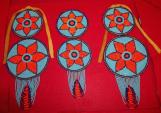 Credits:
Credits:Anne Reid
14
Rosette and Necklace, or Bolo Tie - "Poisstammaan" (ornament)Circa 1960s
Fort Whoop-Up National Historic Site
 Credits:
Credits:Gord Tolton
